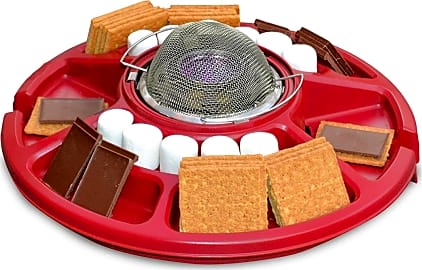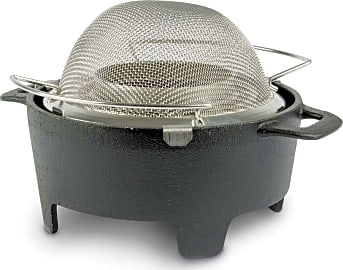The 10 Best S'mores Makers

This wiki has been updated 39 times since it was first published in October of 2015. We all know the best part of any camping trip is roasting marshmallows over a fire and indulging in a gooey treat. These convenient home s'mores makers allow you and your family to get a delicious chocolate-filled fix anytime you like, without having to sleep in a tent or worry about swatting mosquitoes. With electric and canned fuel options, there's one for every preference. When users buy our independently chosen editorial picks, we may earn commissions to help fund the Wiki.
Editor's Notes
February 06, 2020:
Although we like the fun design, the Hershey's 6203 is no longer easy to find, so we have elected to remove it; the same goes for the NutriChef Maker Station. But there remain plenty of great options, including the popular Nostalgia Indoor. There's no open flame to worry about, and the plastic trays are BPA-free for your peace of mind. For those who don't want a plastic model, we've added the Chicago Metallic White. A ceramic option, it has eye-catching "grown-up" styling that should be just as welcome at a serious event as at a kid's party. If you'd rather go the microwave route, there's the Prep Solutions by Progressive; treat its arms gently, though, because they weren't made to take a lot of abuse. Finally, for s'mores lovers who want something to make campfire treat making easier, we selected the Ajmyonsp Roasting Sticks. These telescoping forks are cleaner than sticks from the ground, and they arrive in a canvas bag, so you won't lose them. They might also be used as a hot dog cooker, although really heavy brats or sausages can cause them to bend.
What Exactly Is A S'Mores Maker And Why Do You Want One?
But, like with many human tasks, a device has been created to streamline the s'mores making process.
For many people who grew up camping, a s'mores maker is simply the title for the person in charge of starting the fire, putting marshmallows on sticks and breaking up the graham crackers and chocolate bars. But, like with many human tasks, a device has been created to streamline the s'mores making process. These helpful devices come in various shapes and styles, but they all consist of some heating element over which users can hold marshmallows as they melt, or even place entirely assembled sandwiches directly on top of for grilling.
Some have special rack designs that can go on a barbecue, which is ideal for the camper who still makes meals in the great outdoors but is foregoing the use of an open flame due to the staggering outdoor fire statistics. S'mores makers often have designated compartments for all of the usual ingredients, along with roasting sticks made from food grade materials. There are various types of natural twigs that are safe for marshmallow roasting, but most people do not have the tree varieties growing in their back yard. So using the included sticks is the safest option.
S'mores makers don't only offer a safe way to make this classic treat, they also help on a rainy day. Those who want the timeless s'mores experience but live in rainy weather likely cannot keep a firepit active. An electric s'mores maker works no matter what the weather is like. They can bring the feeling of a great outdoor camping trip to one's living room or kitchen.
Styles, Accessories, And Other Features
Engaging in one-on-one activities with one's children is very important for family bonds. For parents who do not have time to sit down to a full dinner with their children, making s'mores together can be a good alternative. Parents who are purchasing a s'mores maker for their children should look for certain kid-safe features, like a totally covered heat source, and a safety burner fuel holder. For those who prefer to not keep any fuel in the house, many models are electrically powered.
These allow the user to place their fully-assembled s'more into small cages, that then go into the entirely closed device.
One common problem that occurs when roasting marshmallows over an open flame is that they burn. There are several hazards associated with eating burnt food. Some s'mores makers solve this problem with an oven-like design that evenly heats the marshmallows from all directions. These allow the user to place their fully-assembled s'more into small cages, that then go into the entirely closed device. One of the perks of using a s'mores maker is that these devices can heat up in mere seconds.
Those hoping to create a real camping feel inside of their home can look for a s'mores maker with creative additions like fake logs underneath the heating element, or roasting sticks that look like real twigs. Marshmallows can get quite messy when heated up, so make sure the cooking element of your s'mores maker can go in the washing machine or is at least made from non-stick materials. For those who like to get creative with their s'mores and add non-traditional ingredients, some models have extra large trays for things like various chocolate bars and cookies.
The History Of S'Mores
The history of s'mores is as sticky as the treats themselves. The first documented recipe of the food was in the 1927 book "Tramping and Trailing with the Girl Scouts." In this version, s'mores were originally named Some Mores. But many food historians argue that there were inspirations for the food as early as the Victorian Era, when elite tea party platters were often adorned with cookie sandwiches with various creamy fillings.
In the Middle Ages, mallow came from a swamp plant called the Althaea Officinalis.
Some say, however, that the Moon Pie, created in 1917, was the original s'more, since it consists of two graham cracker cookies that have been dipped in chocolate, and filled with marshmallow. Others contest that the Mallomar, first seen in 1913 in New Jersey, was the first inspiration for the s'more. Mallomars are made with one graham cracker cookie, topped with marshmallow and coated in chocolate.
One can easily see how it is difficult to pinpoint exactly when the s'more came to be. What historians do know is that the star ingredient, the marshmallow, as we know it today is very different than its original form. In the Middle Ages, mallow came from a swamp plant called the Althaea Officinalis. Its roots created a sticky, sweet substance that was candied and added to foods. Since then, manufacturers have added things like sugar and gelatin to make modern day marshmallows.















